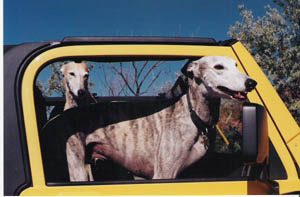Greyhounds, because of their lack of fat and hair, don’t have the insulation other dogs have to the heat, so they are affected much more quickly. Nerve, heart, brain damage, and of course, death are the deadly results of heat. They like it best at 68 – 72 degrees. My Dad, in Florida, keeps his house at 79 degrees, except when the dogs and I visit. Then it’s turned to 72 degrees, and he puts on a fleece jacket and wool cap.
WATER
Water, water, water. Always have water in the car, and with you on walks.
Ice – Take a thermos full of ice with you
Squirt Bottle – Bring a squirt bottle filled with cold, ice water everywhere you go. Squirt often. Wet ear, necks, legs, paw pads and belly.
Cool Coats – Using a cotton terry cloth towel, wet it and drape it over your greyhound. You can also use a dog coat pattern and make one for your greyhound. But you must not let this coat get hot, or it traps in the heat, vs cooling the dog down. So it must be dipped in cool water frequently.
Pools – greyhounds love to sit in wading pools. They think they are the epitome of cool splayed out in these kiddie pools, staying cool.
ACTIVITIES
Walks – the best time is early morning. Street pavements are cooler and so is the air temperature. Only walk very short distances. Panting is always a sign of distress. Do NOT walk your greyhound during the day, or even early evenings. Pavements are very hot, and it’s been a full day of heat. Test all walking surfaces by putting your bare feet on them. If you can’t walk on a surface, neither can your greyhound.
Keep your greyhound indoors with air conditioning at all times. No traveling without air conditioning – ever!
Monitor your greyhound’s play at all times during hot weather. They may not know when enough is enough. Put the sprinkler system on when they are playing, this will help to keep them cool.
If they appear hot, hose them down, or apply wet towels around the belly and between the legs. Be safe, not sorry.
HEAT EXHAUSTION SIGNS
Quick action can save your dog’s life, if you have allowed him to reach any of these signs. It is your responsibility to PREVENT these signs from ever happening: Excessive panting; Skin on inside of ears becomes flushed and red; Weakness; Walk becomes wobbly; Fainting.
Get cool water, not cold, on him – all over him – anyway you can. Put him in a bath tub, hose him down, or take cotton towels, wet them down, and keep putting them all over the dog. Keep the clothes cool. Do not let them get hot and stay on the body. Then get to a vet!
CARS
Outside Temp Inside Car Temp
Degrees 10 min. 30 min.
70 89 104
75 94 109
80 99 114
85 104 119
90 109 124
95 114 129
Whether windows are open or not does not matter. Additionally, if you leave your dog in a car with the air conditioner on, and the engine shuts down, your dog will die.
Important Info from Lure Coursing People
Heat is lost from a body by evaporation, radiation and convection (mass transfer). Sweating cools you by evaporation. Black animals re-radiate heat better than white animals.
Being submerged in cool water, having a breeze blow on you or having water from a hose run over you are all ways of having convective cooling.
If it is very humid, then evaporative cooling is relative ineffective and convective cooling becomes the most important mode.
Dogs do not sweat to cool off. They get rid of heat by panting and submerging in water. After they submerge they can get out of the water and loose heat as the water evaporates
but they will need to submerge again to restore a water film once they dry off.
The ability to generate heat is proportional to the dog’s body mass. The ability to cool off is proportional to surface areas: tongue, ears, inside of mouth, lung surface, legs and the rest of the body.
Since mass increases geometrically but surface area increases arithmetically larger and bulkier dogs overheat MUCH more easily than smaller and thinner dogs. In practical terms, if you have a large dog or a hairy dog just misting its coat with a spray of water from a mister on a hot humid day is NOT going to cool the dog off. Neither is allowing it to drink a lot of water.
A dog needs to be submerged or hosed down and it needs to be in the shade. If the dog has just run he should be walked to aid in cooling but this does not substitute for hosing down or submerging.
Since dogs obtain a fair amount of evaporative cooling through heavy panting the dog’s mouth can be moistened.
A hot dog should not stand around in a muzzle. The muzzle can seriously interfere with panting.
Dogs in heat stroke may feel clammy to the touch. While going into heatstroke they may produce copious quantities of thick, ropey saliva. Seizures can be a consequence of heat stroke.
Dogs are more sensitive to heat and high humidity than humans. A situation that may be merely very uncomfortable for you may kill your dog. A dog’s normal body temperature is between 101 – 102.5 degrees. A dog can only withstand a high body temperature for a short time before suffering nerve damage, heart problems, liver damage, brain damage and death.
Humidity kills. Dogs can get heat stroke in 80 degree weather if it is humid enough. Dogs take longer to acclimate to climatic changes involving increased heat and humidity than people and they will lose that acclimation over a period of cool weather.
